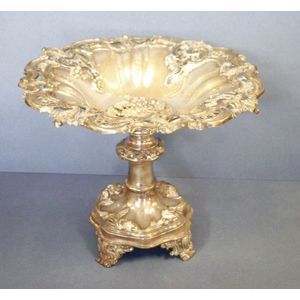Victorian Grape Comport with Silver Putti Base
You must be a subscriber, and be logged in to view price and dealer details.
Subscribe Now to view actual auction price for this item
When you subscribe, you have the option of setting the currency in which to display prices to $Au, $US, $NZ or Stg.
- Putto / Putti / Amorino / Amorini - A putto (plural: putti) or amerino (plural: amerini) is a cherub or cupid frequently appearing in both mythological and religious paintings and sculpture, especially of the Renaissance and Baroque periods and later used as a decorative element in the design of furniture, ceramics, statuary etc. They are usually depicted as chubby males, or of indeterminate gender, often with wings. Their depiction may represent an association with love, heaven, peace or prosperity.
- Victorian Period - The Victorian period of furniture and decorative arts design covers the reign of Queen Victoria from 1837 to 1901. There was not one dominant style of furniture in the Victorian period. Designers used and modified many historical styles such as Gothic, Tudor, Elizabethan, English Rococo, Neoclassical and others, although use of some styles, such as English Rococo and Gothic tended to dominate the furniture manufacture of the period.
The Victorian period was preceded by the Regency and William IV periods, and followed by the Edwardian period, named for Edward VII (1841 ? 1910) who was King of the United Kingdom and the British Dominions and Emperor of India for the brief period from 1901 until his death in 1910. - Comport - A comport is a type of decorative serving dish or bowl, typically used for desserts, fruits or other sweet treats. The comport is usually made from glass, silver or porcelain, which are materials known for their elegance and durability. They are often beautifully designed and decorated, and can be used as an elegant and decorative centerpiece for a table or dining room. They are also widely used as a decorative piece on the mantelpiece, sideboard, or other areas of the house.
This item has been included into following indexes:
Visually similar items

A silver plated single trumpet centre piece. 43 cm high

A sterling silver comport, scalloped rim with openwork design rim, raised on well ornamented symmetric feet. Ccp, London 1905. Diameter 15 cm. Height 8 cm. Weight 252g.

Mid 19th century Swedish silver centrepiece bowl, hallmarked 1846 (under side of top near edge and on top of bottom rim), 833/1000 purity, maker G.M., 36 cm, 36 cm, 25.5 cm high, 1205 grams

A pair of Dresden china lamps with shades, urn form white and gilded lamp bases with oval cream silk shades with trims; blue backstamp underside. Height 45 cm
